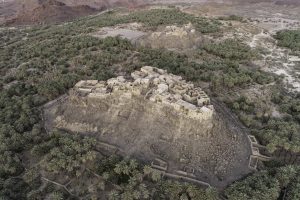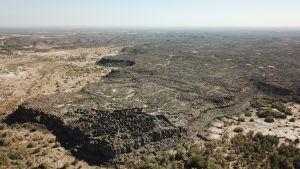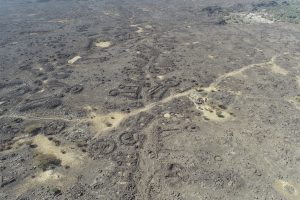Khaybar (Arabie saoudite)
L’oasis de Khaybar, dans la province de Médine à l’ouest de l’Arabie Saoudite, est un haut lieu de l’histoire du Hijaz. Elle a été préservée pendant des millénaires, et semble avoir abrité des populations humaines sans interruption, des premiers temps de la préhistoire jusqu’à nos jours. Elle est surtout célèbre pour avoir été le théâtre de la bataille de Khaybar en 628, qui s’est soldée par la victoire des forces musulmanes sur les populations juives autochtones.

Villages perchés de Nizar et Munifah dans l’oasis de Khaybar, ©Khaybar Longue Durée Archaeological Project (AFALULA/CNRS/RCU)
Le nouveau projet de prospection et de fouilles archéologiques de Khaybar (Khaybar Longue Durée Archaeological Project) a débuté en octobre 2020, et durera jusqu’à la fin de 2024. L’objectif principal est d’établir une première documentation archéologique afin de cerner les grandes étapes de l’occupation humaine et la dynamique environnementale de l’oasis de Khaybar au fil du temps.
Au cours des quatre premières campagnes de terrain, de 2020 à 2022, la mission archéologique a fait des découvertes majeures sur le rôle de Khaybar comme lieu de vie privilégié en milieu désertique. D’autres travaux de cartographie sont nécessaires, mais à ce jour, les recherches menées à Khaybar mettent déjà en évidence la complexité de l’organisation du paysage, des espaces communautaires, des réseaux de canaux et de leur relation avec les sites d’habitation. Khaybar a donc été habitée pendant une longue période, émergeant dès la préhistoire, et se développant progressivement avec les contributions des civilisations successives durant des millénaires.

Village abandonné d’Asmiah (19e s.), sur le plateau basaltique dans l’oasis de Khaybar, ©Khaybar Longue Durée Archaeological Project (AFALULA/CNRS/RCU)
English version
The Khaybar Oasis, located in western Saudi Arabia, is a hotbed of local history. It has been preserved for millennia, and its human occupation seems to have been virtually uninterrupted from earliest prehistoric times to the present day. It is most renowned for the battle of Khaybar that took place in 628 ce, which ended with the victory of Muslim forces against local Jewish populations.
The new Khaybar archaeological survey and excavation project began in October 2020, and will last until the end of 2024. It is co-directed between G. Charloux (CNRS, UMR-8167 Orient & Méditerranée) and R. Crassard (CNRS, UMR-5133 Archéorient), with M. AlMushawh (Royal Commission for AlUla, RCU); it is funded by the French Agency for AlUla Development (AFALULA, France), in partnership with RCU (Saudi Arabia) and the French National Centre for Scientific Research (CNRS). The main objective of the project is to provide new archaeological documentation to understand human occupation and the environmental dynamics of the Khaybar oasis over time.
Along the first four seasons of fieldwork in from 2020 to 2022, the archaeological project yielded new discoveries on the significance of Khaybar as a privileged living place in the desert. Human groups were using natural resources in the area as early as the first times of prehistory, until today. Further mapping work is required, but to date the work in Khaybar already highlights the complexity of the organisation of landscape, community spaces, canal networks and their relationship to settlement sites. Khaybar was thus inhabited during a long span of time, originating in the prehistory, and gradually developing with the contribution of ancient societies and successive civilizations over thousands of years.

vue aérienne d’une « allée funéraire ». Des dizaines de tombes monumentales sont disposées régulièrement le long d’un axe. Ces allées se comptent par centaines en Arabie du nord-ouest et formaient des réseaux complexes dont on ignore encore la signification, ©Khaybar Longue Durée Archaeological Project (AFALULA/CNRS/RCU)
Articles
Barge O., Albukaai D., Boelke M., Guadagnini K., Régagnon E., & Crassard R., 2022, « New Arabian Desert Kites and Potential Proto-Kites Extend the Global Distribution of Hunting Mega-Traps ». Journal of Archaeological Science: Reports 42 (1 avril 2022). https://doi.org/10.1016/j.jasrep.2022.103403.
Charloux G., Crassard R., AlMushawh M., Albukaai D., Chung-To G., Depreux B., Guadagnini K., Hapiot L., Hilbert Y.H., McPhillips S., Norris J., Régagnon E., Shabo S. and Alshilali S., 2022 (accepted, in press), Khaybar Through Time. First results of the Khaybar Longue Durée Archaeological Project (2020−2021) in the light of historical sources, Supplement to the Seminar for Arabian Studies 2021.




